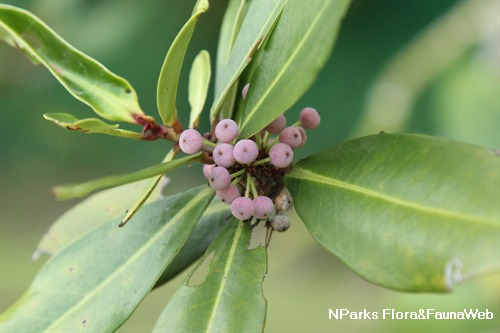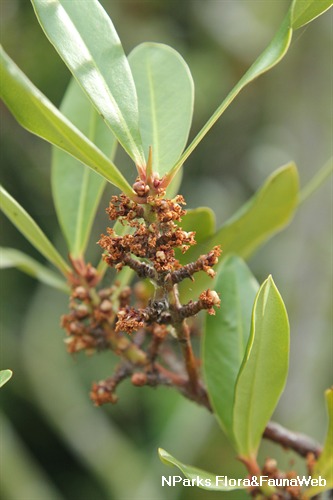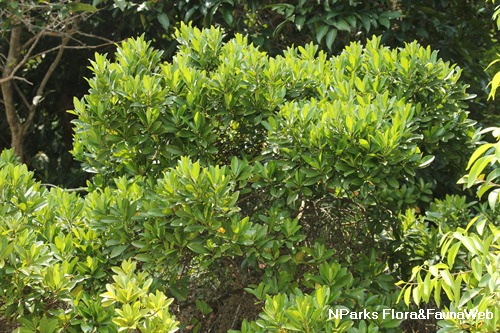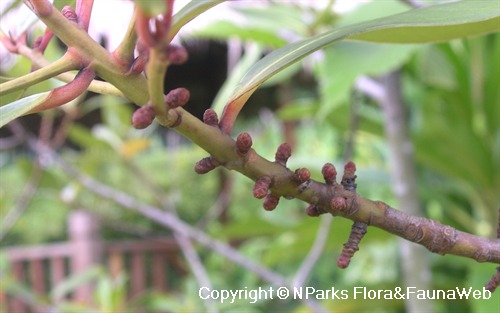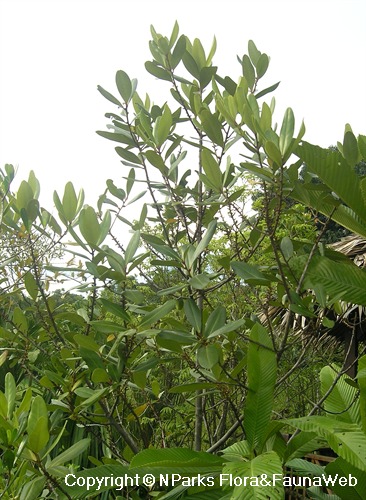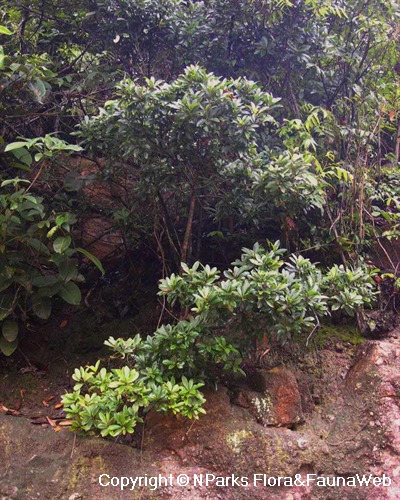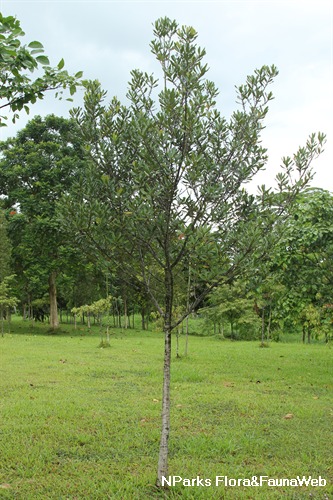
Back
Myrsine capitellata Wall.
| Family Name: | Primulaceae |
| Synonyms: | Rapanea porteriana (Wall. ex A.DC.) Mez, Rapanea capitellata (Wall.) Mez |
| Common Name: | Kicar, Kicar-kicar |
Name
Classifications and Characteristics
| Plant Division | Angiosperms (Flowering Seed Plants) (Dicotyledon) |
|---|---|
| Plant Growth Form | Tree (Small (6m-15m)), Shrub |
| Lifespan (in Singapore) | Perennial |
| Mode of Nutrition | Autotrophic |
| Plant Shape | Oval, Conical, Irregular |
| Maximum Height | 10 m |
Biogeography
| Native Distribution | Thailand, Sumatra, Peninsular Malaysia, Singapore and Borneo |
|---|---|
| Native Habitat | Terrestrial (Coastal Forest, Mountain), Shoreline (Mangrove Forest, Sandy Beach, Rocky Beach) |
| Preferred Climate Zone | Tropical, Sub-Tropical / Monsoonal |
| Local Conservation Status | Native to Singapore (Endangered (EN)) |
Description and Ethnobotany
| Growth Form | It is a shrub or tree up to 10 m tall, with grey-coloured bark. |
|---|---|
| Foliage | Its alternate, shortly-stalked leaves have leaf blades that are oblong-lance-shaped, dark green, and 3–9 by 1.3–3.5 cm, with scarcely visible venation. Numerous oil glands are found on the leaf blades, like minute lenses. These oil glands are visible when a fresh leaf is held up against a light source. |
| Flowers | Its 5 mm-wide flowers are arranged in a compact cluster, on stubby inflorescence stalks along the stems. |
| Fruit | Its 1-seeded, round fruits ripen from pale green to pinkish purple, and are 2.5–5 mm wide. |
| Habitat | It grows on muddy (mangrove forest), rocky and sandy coasts, or swamps. It also grows on top of hills and mountains up to 1,700 m altitude. |
| Associated Fauna | Its fruits are eaten by bulbuls. |
| Cultivation | It can be propagated by seed. |
Landscaping Features
| Landscaping | It has beautiful bluish purple fruits, and can be maintained as a hedge through regular pruning. It is a shrub or tree suitable for gardens, parks and roadsides. |
|---|---|
| Desirable Plant Features | Ornamental Fruits |
| Landscape Uses | Coastal, Suitable for Roadsides, General, Parks & Gardens, Beachfront / Shoreline |
Fauna, Pollination and Dispersal
| Fauna Pollination Dispersal Associated Fauna | Bird-Attracting (Fruits, Associated with: Pycnonotus goiavier) |
|---|---|
| Pollination Method(s) | Biotic (Fauna) |
| Seed or Spore Dispersal | Biotic (Fauna) |
Plant Care and Propagation
| Light Preference | Full Sun, Semi-Shade |
|---|---|
| Water Preference | Moderate Water, Lots of Water |
| Plant Growth Rate | Moderate |
| Rootzone Tolerance | Well-Drained Soils, Waterlogged Soils (Drains Site), Moist Soils, Saline Soils / Salt Spray, Fertile Loamy Soils |
| Propagation Method | Seed |
Foliar
| Foliage Retention | Evergreen |
|---|---|
| Mature Foliage Colour(s) | Green |
| Mature Foliage Texture(s) | Leathery |
| Foliar Type | Simple / Unifoliate |
| Foliar Arrangement Along Stem | Alternate, Spiral |
| Foliar Attachment to Stem | Petiolate |
| Foliar Shape(s) | Non-Palm Foliage (Oblanceolate) |
| Foliar Venation | Pinnate / Net |
| Foliar Margin | Entire |
| Typical Foliar Size | 4 cm to 8 cm |
Floral (Angiosperm)
| Flower & Plant Sexuality | Bisexual Flowers |
| Flower Colour(s) | White, Yellow / Golden |
|---|---|
| Flower Grouping | Cluster / Inflorescence |
| Flower Location | Axillary |
| Inflorescence Type | Umbel |
| Flower Size | 0.5 cm |
Fruit, Seed and Spore
| Mature Fruit Colour(s) | Pink, Purple |
|---|---|
| Fruit Classification | Simple Fruit |
| Fruit Type | Fleshy Fruit , Drupe |
| Seed Quantity Per Fruit | Few (1-5) |
Image Repository
Others
| Master ID | 29412 |
|---|---|
| Species ID | 3721 |
| Flora Disclaimer | The information in this website has been compiled from reliable sources, such as reference works on medicinal plants. It is not a substitute for medical advice or treatment and NParks does not purport to provide any medical advice. Readers should always consult his/her physician before using or consuming a plant for medicinal purposes. |


